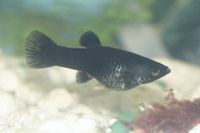Molly (Poecilia sphenops)
From The Aquarium Wiki
(Redirected from Balloon molly)
Poecilia sphenops
57 Litres (15 US G.)
6-10 cm (2.4-3.9")
7 - 8.2
18 -28 °C (64.4-82.4°F)
7-20 °d
1:2 M:F
2-3 years
Family
Poeciliidae
This animal is available captive bred
Contents
Additional names
- Green Molly, Black Molly, Dalmatian Molly, Mexican Molly, Pointed-Mouth Molly, Molly
Additional scientific names
- Mollienisia sphenops, Poecilia thermalis, Gambusia modesta
Origin[edit]
- Central and South America: Mexico to Colombia.
Sexing[edit]
- Males are much smaller and have a modified anal fin called a gonopodium which allows the male to deposit sperm.
Breeding[edit]
- In the wild Mollies shoal in their hundreds to billions, and the ratio of males to females is one to two. Indeed, a female molly would typically give birth to 70% females.
- Pet shops often sell Mollies in pairs. Whilst this will not cause the female any long term harm, it will tire the female as she is constantly pestered by the male's advances. It is far better for the fish if you have a male to every 2 females and then the females will be less stressed. Every 30-40 days you'll have 50-100 live fry.
- The female has the ability to store sperm for several months if the male should disappear.
- Adults will prey on young fry, so dense planting in the form of Java Moss can be used to ensure fry survival, or the young fry can be put into a breeding trap until they are larger. Pregnant females should never be placed into a breeding trap as this will cause undue stress and possibly cause them to abort the fry.
Tank compatibility[edit]
- A popular choice for a beginners aquarium, the molly is a good community fish that will generally not bother other inhabitants, they may harass other livebearers, including Platies, however. It is known for Mollies to be a little nippy, however, so any tank mates should be fast swimming and not be long-finned.
Diet[edit]
- Flake, dried fish food. Mollies will eat a small amount of meat. Raw cockles, Bloodworm, etc. It will even eat a small amount of soft algae if not over fed. They also like to eat some blanched vegetables like courgette, cucumber or lettuce.
Feeding regime[edit]
- Feed once or twice a day.
Environment specifics[edit]
- Originally from a brackish water source in the wild; however, most are now tank bred will live in freshwater.
- It must be noted that keeping Mollies in an entirely salt-free environment can be detrimental to their health. One of the sicknesses they are prone to if kept this way is the "Shimmies", which will appear as erratic swimming.
Behaviour[edit]
- Top feeders (see mouth shape) but will take food at any level of the tank. Known for their ability to clean the water surface of tanks. Quickly becomes used to the aquarist and will feed out of your hand. Can be boisterous.
Identification[edit]
- Often confused with young Poecilia velifera or with Poecilia latipinna. Mollys have quite a thick-set chunky body and their fins are not elongated but quite rounded. The dorsal, especially if hybridised with other hi-fin mollies, can be tall and angular and be down the whole of the dorsal posterior of the fish. They have a pointed head and mouth.
- Through selective breeding many colour, dorsal and tail-shape variations have been created, including an uncommon lyretail, and many colours including the popular dalmatian.
Pictures[edit]
External links[edit]
- Fishbase (Mirrors:
 )
)






